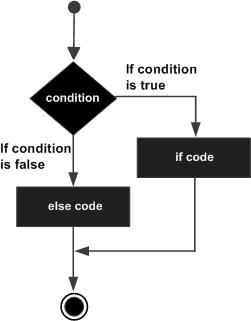C ++ if ... else statement
After aif statement with an optional else statement,else statement executes the Boolean expression is false.
grammar
C ++ syntax ofif ... else statement:
if(boolean_expression)
{
// 如果布尔表达式为真将执行的语句
}
else
{
// 如果布尔表达式为假将执行的语句
}
If the Boolean expression istrue, then the code ifthe execution block. If the Boolean expression isfalse, then the code within the elseblock executed.
flow chart

Examples
#include <iostream>
using namespace std;
int main ()
{
// 局部变量声明
int a = 100;
// 检查布尔条件
if( a < 20 )
{
// 如果条件为真,则输出下面的语句
cout << "a 小于 20" << endl;
}
else
{
// 如果条件为假,则输出下面的语句
cout << "a 大于 20" << endl;
}
cout << "a 的值是 " << a << endl;
return 0;
}
When the above code is compiled and executed, it produces the following results:
a 大于 20 a 的值是 100
if ... else if ... else statement
After aif statement with an optional else if ... elsestatement, which can be used to test a variety of conditions.
When using if ... else if ... else statement, the following points should be noted:
- Available with a zero or after a if else, else must after all else if.
- If the latter can be followed by zero or more else if, else if necessary before else.
- Once a successful match else if, else if or else the other will not be tested.
grammar
C ++ The syntax ofif ... else if ... else statement:
if(boolean_expression 1)
{
// 当布尔表达式 1 为真时执行
}
else if( boolean_expression 2)
{
// 当布尔表达式 2 为真时执行
}
else if( boolean_expression 3)
{
// 当布尔表达式 3 为真时执行
}
else
{
// 当上面条件都不为真时执行
}
Examples
#include <iostream>
using namespace std;
int main ()
{
// 局部变量声明
int a = 100;
// 检查布尔条件
if( a == 10 )
{
// 如果 if 条件为真,则输出下面的语句
cout << "a 的值是 10" << endl;
}
else if( a == 20 )
{
// 如果 else if 条件为真,则输出下面的语句
cout << "a 的值是 20" << endl;
}
else if( a == 30 )
{
// 如果 else if 条件为真,则输出下面的语句
cout << "a 的值是 30" << endl;
}
else
{
// 如果上面条件都不为真,则输出下面的语句
cout << "没有匹配的值" << endl;
}
cout << "a 的准确值是 " << a << endl;
return 0;
}
When the above code is compiled and executed, it produces the following results:
没有匹配的值 a 的准确值是 100
